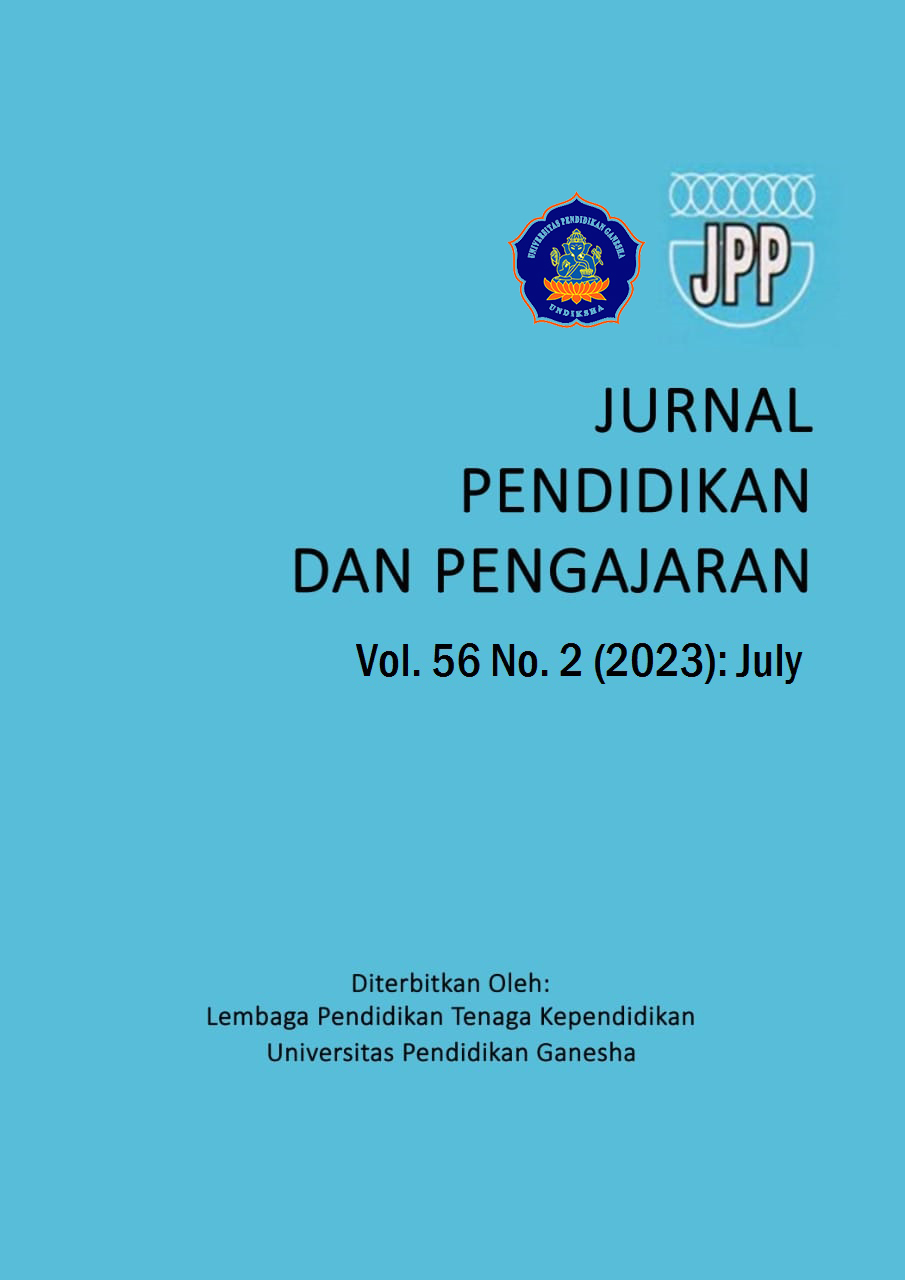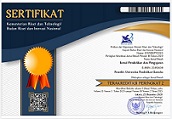The Effectiveness of Scratch Learning Media Using the PMRI Approach to Improving Students’ Learning Outcomes
DOI:
https://doi.org/10.23887/jpp.v56i2.66086Kata Kunci:
Scratch Learning Media, Learning Outcomes, PMRIAbstrak
In the process of learning mathematics, the teacher always strives for the material presented to be well understood by students, with the intention that the objectives of learning can be achieved properly. This study aimed to analyze the effectiveness of scratch learning media with the PMRI approach in improving student learning outcomes. The type of research used was research and development referring to the ADDIE model. The development stage consists of 3 stages: preliminary stage, development stage, and testing stage. The data collection instrument used expert validation sheets, student and teacher response questionnaires, and test questions. The process of effectiveness through validation on scratch learning media with the PMRI approach and also measuring the practicality of scratch media with the PMRI approach through student and teacher response questionnaires, while the effectiveness of scratch learning media with the PMRI approach through the test given questions. The results obtained showed that the scratch learning media with the PMRI approach is declared valid with an average score of 70.28% in the valid category. Scratch learning media with the PMRI approach was said to be practical with an average score of 82.61% in the very practical category. Scratch learning media with effective criteria from learning test results with a score of 2.1286 > 2.0057 which meant learning outcomes using scratch learning media with the PMRI approach were better than learning outcomes without using scratch learning media with the PMRI approach, so that scratch learning media with the PMRI approach was effective in improving learning outcomes.
Referensi
Agustiningsih. (2015). Video sebagai alternatif media pembelajaran dalam rangka mendukung keberhasilan penerapan kurikulum 2013 di sekolah dasar. PEDAGOGIA: Jurnal Pendidikan, 4(1), 55–68. https://doi.org/10.21070/pedagogia.v4i1.72. DOI: https://doi.org/10.21070/pedagogia.v4i1.72
Astriyani, A., & Zahra, A. I. (2021). Inovasi Media Pembelajaran Materi Aritmatika Sosial Berbasis Mobile Android Untuk Mendukung Kemampuan Spasial Visual Siswa Smp Kelas VIII. EMTEKA: Jurnal Pendidikan Matematika, 2(1), 25–36. https://doi.org/10.24127/emteka.v2i1.735. DOI: https://doi.org/10.24127/emteka.v2i1.735
Faot, M. M., & Amin, S. M. (2020). Pengaruh Pendekatan Pendidikan Matematika Realistik Indonesia (PMRI) Terhadap Hasil Belajar Siswa. MATHEdunesa, 9(1), 55–60. https://doi.org/10.26740/mathedunesa.v9n1.p55-60. DOI: https://doi.org/10.26740/mathedunesa.v9n1.p55-60
Fitrianingsih, E. Y., Akhyar, M., & Efendi, A. (2023). Augmented Reality Development Opportunities in Geometry Learning for Elementary Students. Jurnal Pendidikan Dan Pengajaran, 56(1), 114–125. https://doi.org/10.23887/jpp.v56i1.51238. DOI: https://doi.org/10.23887/jpp.v56i1.51238
Ivanović, M., Putnik, Z., Komlenov, Ž., Welzer, T., Hölbl, M., & Schweighofer, T. (2013). Usability and privacy aspects of moodle: Students’ and teachers’ perspective. Informatica (Slovenia), 37(3), 221–230. https://www.informatica.si/index.php/informatica/article/download/451/455.
Khairani, M., & Febrianal, D. (2016a). Pengembangan Media Pembelajaran Dalam Bentuk Macromedia Flash Materi Tabung Untuk Smp Kelas Ix. Jurnal Iptek Terapan, 10(2), 95–102. https://doi.org/10.22216/jit.2016.v10i2.422.
Khairani, M., & Febrianal, D. (2016b). Pengembangan Media Pembelajaran Dalam Bentuk Macromedia Flash Materi Tabung Untuk SMP Kelas IX. Jurnal Ipteks Terapan Research of Applied Science and Education, 10(2), 95–102. https://doi.org/10.22216/jit.2016.v10i2.422. DOI: https://doi.org/10.22216/jit.2016.v10i2.422
Khotimah, D. I., Andayani, S., & Sudarman, S. W. (2020). Pengembangan Handout dengan Pendekatan Pendidikan Matematika Realistik Indonesia (PMRI) untuk Memfasilitasi Penalaran Matematis. Emteka: Jurnal Pendidikan Matematika, 1(1), 36–45. https://doi.org/10.21274/jtm.2022.5.2.123-134. DOI: https://doi.org/10.24127/emteka.v1i1.379
Krüger, J. M., & Bodemer, D. (2022). Application and Investigation of Multimedia Design Principles in Augmented Reality Learning Environments. Information (Switzerland), 13(2). https://doi.org/10.3390/info13020074. DOI: https://doi.org/10.3390/info13020074
Kurniawan, A., Kuat, T., & Purnawan, P. (2020). Practicum Workshop and Learning Media Quality in the Light Vehicle Engineering Department of Vocational High Schools. Journal of Vocational Education Studies, 3(1), 49. https://doi.org/10.12928/joves.v3i1.2143. DOI: https://doi.org/10.12928/joves.v3i1.2143
Lee, William & Owens, D. (2004). Multimedia-Based Instructional Design. Pfeiffer.
McCrudden, M. T., & Rapp, D. N. (2017). How Visual Displays Affect Cognitive Processing. Educational Psychology Review, 29, 623–639. https://doi.org/10.1007/s10648-015-9342-2. DOI: https://doi.org/10.1007/s10648-015-9342-2
Nasution, S. H., Anwar, L., Sudirman, S., & Susiswo, S. (2015). Pengembangan Media Pembelajaran Untuk Mendukung Kemampuan Penalaran Spasial Siswa Pada Topik Dimensi Tiga Kelas X. Jurnal Keguruan Dan Ilmu Pendidikan, 4(2), 903–913. https://doi.org/10.47178/jkip.v4i2.66.
Nuraenahfisah, N., & Toheri, T. (2013). Pengaruh Penggunaan Scratch Terhadap Kreativitas Berfikir Matematis (Studi Eksperimen Terhadap Siswa Kelas VIII MTs Negeri Ketanggungan Kabupaten Brebes). Eduma : Mathematics Education Learning and Teaching, 2(1). https://doi.org/10.24235/eduma.v2i1.65. DOI: https://doi.org/10.24235/eduma.v2i1.65
Rahmawati, D., & Permata, L. D. (2018). Analisis Kesalahan Siswa Dalam Menyelesaikan Soal Cerita Program Linear Dengan Prosedur Newman. Jurnal Elektronik Pembelajaran Matematika, 5(2), 173–185. https://jurnal.uns.ac.id/jpm/article/view/26050.
Rahmawati, Zuliani, R., & Puspita Rini, C. (2021). Analisis Kesulitan Belajar Matematika Pada Siswa Kelas V Sdn Karawaci 11. NUSANTARA : Jurnal Pendidikan Dan Ilmu Sosial, 3(3), 478–488. https://ejournal.stitpn.ac.id/index.php/nusantara/article/view/1515.
Rohaeti, E. E., & Bernard, M. (2018). the Students’ Mathematical Understanding Ability Through Scientific-Assisted Approach of Geogebra Software. Infinity Journal, 7(2), 165. https://doi.org/10.22460/infinity.v7i2.p165-172. DOI: https://doi.org/10.22460/infinity.v7i2.p165-172
Sa’ida, N. (2021). Implementasi Model Pembelajaran STEAM Pada Pembelajaran Daring. Jurnal Review Pendidikan Dasar: Jurnal Kajian Pendidikan Dan Hasil Penelitian, 7(2), 123–128. https://doi.org/10.26740/jrpd.v7n2.p123-128. DOI: https://doi.org/10.26740/jrpd.v7n2.p123-128
Sjahruddin, H., Ramli, M., Anaconda Bangkara, B., & Fatmawati, E. (2022). Technological Innovation to Support 21st Century Learning Outcomes and Sustainability at Universitas Islam Negeri (UIN) Antasari. Jurnal Iqra’ : Kajian Ilmu Pendidikan, 7(1), 63–76. https://doi.org/10.25217/ji.v7i1.1473. DOI: https://doi.org/10.25217/ji.v7i1.1473
Skaraki, E., Kalogiannakis, M., Ampartzaki, M., & Papadakis, S. (2018). Teaching natural science concepts to young children with mobile devices and hands-on activities. A case study. International Journal of Teaching and Case Studies, 9(2), 171. https://doi.org/10.1504/ijtcs.2018.10011893. DOI: https://doi.org/10.1504/IJTCS.2018.090965
Sodik, M. A. (2018). Upaya Meningkatkan Hasil Belajar Melalui Media Visual Mata Pelajaran Matematika Siswa Kelas V Mi Darul Ulum Kalibatur. PERSPEKTIVE : Jurnal Program Studi Pendidikan Agama Islam, 09(2), 39–49. http://ejournal.kopertais4.or.id/mataraman/index.php/perspektif/article/view/4105.
Solikah, M., & Novita, D. (2022). The effectiveness of the guided inquiries learning model on the critical thinking ability of students. Jurnal Pijar Mipa, 17(2), 184–191. https://doi.org/10.29303/jpm.v17i2.3276. DOI: https://doi.org/10.29303/jpm.v17i2.3276
Sugiyono. (2012). Metode Penelitian Kuantitatif Kualitatif dan R&B. Alfabeta.
Suraweera, S. A. D. H. N., Yatigammana, M. R. K. N., Jayantha, R. U. H., Pathiranage, D. M., Pasaual, M. K. De, Priyankara, C., & Wijeyarathne, P. G. (2018). Transforming Sri Lankan Education with Interactive Multimedia Technology: The Journey to E-Lankapura. In 2018 National Information Technology Conference (NITC). IEEE. https://doi.org/10.1109/NITC.2018.8550079. DOI: https://doi.org/10.1109/NITC.2018.8550079
Tasya, N., & Abadi, A. P. (2019). Faktor Penyebab Rendahnya Hasil Belajar Siswa. Sesiomedika, 2(1), 660–662. http://repository.lppm.unila.ac.id/9533.
Tosun, N., & Mihci, C. (2020). An examination of digital parenting behavior in parents with preschool children in the context of lifelong learning. Sustainability (Switzerland), 12(18). https://doi.org/10.3390/su12187654. DOI: https://doi.org/10.3390/su12187654
Vargo, J., Nesbit, J. C., Belfer, K., & Archambault, A. (2003). Learning object evaluation: Computer mediated collaboration and inter-rater reliability. International Journal of Computers and Applications, 25(3), 1–8. https://doi.org/10.1080/1206212X.2003.11441703. DOI: https://doi.org/10.1080/1206212X.2003.11441703
Widyastuti, E. (2019). Using the ADDIE model to develop learning material for actuarial mathematics. In Journal of Physics: Conference Series, 1188(1), 012052. https://doi.org/10.1088/1742-6596/1188/1/012052. DOI: https://doi.org/10.1088/1742-6596/1188/1/012052
Winarni, R., Slamet, S. Y., & Syawaludin, A. (2022). Development of Indonesian language text books with multiculturalism and character education to improve traditional poetry writing skills. European Journal of Educational Research, 10(1), 455–466. https://doi.org/10.12973/EU-JER.10.1.455. DOI: https://doi.org/10.12973/eu-jer.10.1.455
Winatha, K. R., Naswan, S., & Ketut, A. (2018). Pengembangan E-modul Interaktif Berbasis Proyek Pada Mata Pelajaran Simulasi Digital Kelas X di SMK TI Bali Global Singaraja. Jurnal Teknologi Pembelajaran Indonesia, 8(1). https://doi.org/10.23887/jtpi.v8i1.2238. DOI: https://doi.org/10.23887/jtpi.v8i1.2238
Yeh, H. C., & Tseng, S. S. (2019). Using the ADDIE model to nurture the development of teachers’ CALL professional knowledge. Journal of Educational Technology & Society, 22(3), 88–100. https://www.jstor.org/stable/26896712.
Zainal, A. (2012). Model Penelitian dan Pengembangan. PT Remaja Rosdakarya.
Unduhan
Diterbitkan
Cara Mengutip
Terbitan
Bagian
Lisensi
Hak Cipta (c) 2023 Fransiska Gusman

Artikel ini berlisensiCreative Commons Attribution-ShareAlike 4.0 International License.
Authors who publish with Jurnal Pendidikan dan Pengajaran agree to the following terms:- Authors retain copyright and grant the journal the right of first publication with the work simultaneously licensed under a Creative Commons Attribution License (CC BY-SA 4.0) that allows others to share the work with an acknowledgment of the work's authorship and initial publication in this journal
- Authors are able to enter into separate, additional contractual arrangements for the non-exclusive distribution of the journal's published version of the work (e.g., post it to an institutional repository or publish it in a book), with an acknowledgment of its initial publication in this journal.
- Authors are permitted and encouraged to post their work online (e.g., in institutional repositories or on their website) prior to and during the submission process, as it can lead to productive exchanges, as well as earlier and greater citation of published work. (See The Effect of Open Access)





